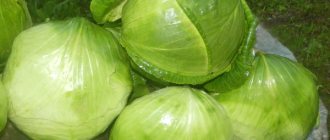Every housewife should know how to store cabbage in the refrigerator, on the balcony, cellar or other place accessible to her. Proper organization of storage will preserve all the vitamins and minerals, taste and presentation of the vegetable. In an unfavorable microclimate, the product will quickly wither or rot, losing its taste and beneficial qualities. Useful tips collected in the article will help you keep cabbage fresh for the winter.
Following simple conditions will help preserve cabbage until the next harvest: choosing the right variety, proper preparation of the vegetable, maintaining optimal temperature and humidity in the room.
Read about storing cauliflower in this article.
General rules for storing cabbage
After harvesting from the ridges, contaminated cabbage heads are washed with running water and inspected for slugs, worms and other pests. Forks are placed in a shaded, ventilated place. Dry the cabbage for no more than a day.
Healthy, strong heads of cabbage that are free of stains are placed for winter storage. The upper leaves are not cut off; they serve as protection from the external environment. If the top leaves have been subjected to the first frost, cut them off and discard them.
Inspect the stalk; it should be dense, without black spots inside or mechanical damage on the outside.
General storage conditions for cabbage
The place for storing cabbage is cool, relative humidity 70-80%, temperature +2 +5°C. The room must be dry, without groundwater, with mandatory ventilation. A cellar, basement, balcony or unheated attic space is suitable for this purpose. When storing cabbage in a dry, warm room, the head of cabbage will dry out. When the temperature drops below 0°C, cabbage leaves, which are 80% water, will freeze.
Preparation
How to store cabbage at home in winter? The most important step in ensuring long-term storage of cabbage is preparation.
It doesn’t matter in what way or in what room you plan to store this vegetable, it needs to be prepared.
Preparation for storage consists of the following steps:
- Choose the best heads of cabbage.
Only the strongest, most complete, high-quality ones are subject to storage. Proper cleaning is important. They must be healthy and not eaten by pests, without signs of rot.There should be no cracks on the forks, especially deep ones. Heads of cabbage that are unsuitable for storage are best consumed first. There is no point in leaving them for the winter, they will not last long;
A good head of cabbage, suitable for storage
- Cut off all excess.
To store cabbage at home, in any case, you need to cut off the stem and remove one layer of the top leaves.Don’t get carried away and “undress” the cabbage too much. The upper leaves perform a protective function. Read how to properly harvest white cabbage here.
Heads of cabbage, processed and stored
- Wash the selected heads of cabbage under running cool water to eliminate the presence of soil or insects between the leaves. After this procedure, the cabbage should be thoroughly dried with a towel.
Remember that late varieties of cabbage, which are removed from the beds before the first frost, are best suited for long-term storage.
Further preparation depends on the chosen storage method. Read more about storing white cabbage on our website.
Storing cabbage in the cellar
Almost every house has a cellar, and in multi-storey buildings there is a basement. Of course, this is the best place to store vegetables; they maintain the necessary microclimate. There are several time-tested methods that will keep cabbage fresh until spring.
In cling film
For this method, cling film is used. Under no circumstances should you use polyethylene; it creates excess moisture and prevents air access. The head of cabbage should be wrapped tightly, on all sides, in 2-3 layers. The stalk should be left at the level of the upper leaves. Make sure that there is no air left under the film. Then the head of cabbage is placed on a wooden rack or hung in a bag.
In boxes
If you have tall wooden boxes in your basement, they are ideal for storing cabbage heads. Thick cardboard is laid at the bottom of the boxes, and the cabbage is laid no higher than 2 layers. This method cannot be called ideal, because when the cabbage leaves come into contact with each other, they become wrinkled, moisture spreads, and the vegetable spoils. But for a couple of months the cabbage will stay in the boxes perfectly.
In paper
Cabbage can be wrapped in thick paper or 2-3 layers of newspaper. With this method, the heads of cabbage are placed on the top shelf in the cellar (basement), with the stalk of the head of cabbage lowered down. By ensuring a distance of 20 cm between the forks, you can preserve cabbage for up to 3 months.
In bags
There are many types of bags for storing vegetables sold in stores; they differ in the size of the bag itself and the size of the cells. For cabbage, you can use both fine-mesh and coarse-mesh mesh, the main thing is that the bags can withstand the weight. Cabbage in bags (nets) is laid out on shelves or on the floor, using wooden pallets for stands.
In sand
To store cabbage in sand, do not remove the roots during harvesting. Cabbage heads are placed in boxes with sand, burying them with their roots down. The sand is compacted tightly, but not watered, otherwise the cabbage will sprout and crack.
Tying up the heads of cabbage
The method our ancestors used. The heads of cabbage are tied together with hemp rope, two at a time, and hung on nails or hooks on the walls. This method is suitable for those cellars (basements) with dry walls. Additional protection from moisture will be cotton fabric, cardboard or newspaper, which is placed between the heads of cabbage and the wall.
Useful tips
Experienced vegetable growers advise:
- If frost occurs unexpectedly, there is no need to immediately cut off the forks. It is better to wait until the frozen cover leaves thaw, after which they can be removed and the heads of cabbage can be sent for long-term storage.
- If, due to lack of free space, cabbage has to be placed in bulk in the cellar, it is advisable to first lay wooden grates on the floor, pre-treated with baking soda, or cover the floor with a layer of straw. But in any case, this storage method does not guarantee long-term preservation of the product.
- But long-term preservation is guaranteed by the method in which each head of cabbage is dipped into a clay mash, then dried and hung by the stalk from the ceiling.
Storing this vegetable in the cellar, where optimal conditions are created for this, allows you to consume fresh cabbage almost all year round - from the previous harvest to the next.
Storing cabbage in the apartment
If the apartment does not have a basement, you can use the balcony if the air temperature is not lower than 2°C. To do this, the balcony must be covered and insulated. You can store cabbage on the balcony by wrapping it in cling film or newspapers. Place cabbage heads up in cardboard boxes with holes for air ventilation. Thick fabric is placed on top of the box. But what if you don't have a basement or balcony? Start preserving cabbage.
Pickling
Salt cabbage in sterilized glass jars. Chop cabbage and carrots into a container. Prepare the brine: add salt, sugar, and spices to taste to the water. Salt/sugar ratio 2:1. Cabbage is placed in jars for 2-3, filled with cold brine. Leave the cabbage in a cool place for 2-3 days. In this form, jars of cabbage are stored on the balcony or in the refrigerator. Shelf life - 2 months.
Pickling
Cut the cabbage into small squares, add chopped carrots. For red cabbage lovers, you can add chopped beets. For brine, take 2 parts sugar, 1 part salt, 5-6 allspice. The brine is boiled, after boiling, add 1 tbsp. 9% vinegar, pour hot brine over the cabbage and put under pressure. After 24 hours, the pickled cabbage is ready and can be stored in the refrigerator for 2 months.
Pickling
The process of sauerkraut differs from pickling in that during pickling, jars of cabbage are left in a warm room in the apartment for 2-3 days. During the fermentation process, liquid will begin to release and increase. In order not to spoil the floor covering, the jars can be placed in a basin or tall pan. During fermentation, hydrogen sulfide with an unpleasant odor accumulates in the jar. Pierce the cabbage with wooden sticks to allow the gas to escape, otherwise the cabbage will be slightly bitter. As soon as the release of water stops, the cabbage has fermented. It is transferred to a cold place for subsequent storage.
Freezing
Freezing the product will help keep cabbage fresh without resorting to preservation. The stalk of the cabbage is cut out, and the pieces of cabbage are placed in plastic bags. In this form, the vegetable can be stored for up to 1 year, but re-freezing cabbage is not recommended. Using this method of storing cabbage, all vitamins and beneficial microelements are preserved.
In vacuum bags
A method of preserving vegetables that is gaining popularity in the modern world. Pieces of cabbage are placed in special bags, and the air is removed from the bags using a vacuum pump. The vacuum storage method guarantees the safety of cabbage leaves for up to six months, storage on the top shelf of the refrigerator or in boxes on the balcony.











